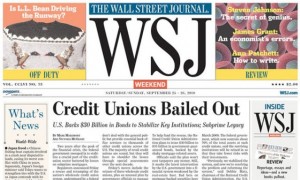From Fashion Trends to Nanotech Trends with The Wall Street Journal
September 30, 2010

After enduring “Fashion Week” taking over the pages of The Wall Street Journal, culminating in The Journal‘s brief and scary transformation to WSJ last weekend, I was beginning to look for another daily source of technology news. The Journal has always been good at spotting tech trends. The “newspaper of record for business” redeemed itself with a special report Monday on The Journal’s 2010 Technology Innovation Awards.
Many of the dozens of winners and runners-up were nanotechnology companies. Echoing my previous report on nanotechnology in water treatment projects, The Wall Street Journal bestowed the Environmental Award to NanoH2O, Inc., for “a nanotechnology-based, reverse-osmosis membrane that promises to reduce the cost of running a typical desalination plant by as much as 25%.”
Many of the awards went to filtration systems, the ones that clean water or clean computers, and those that can turn our waste into useful products in particular. The winner of the Energy Award is InEnTech, LLC, for a plazma gassification process for generating fuel from municipal and industrial waste.
The Gold Winner was a think tank in Taiwan, the Industrial Technology Research Institute (ITRI), which won the award for an elegant process for making thin, flexible video displays. The Wall Street Journal‘s San Francisco news editor, Michael Totty, says the idea for the paper-thin process came from watching pancakes being made. You never know where those Minitrends will strike you!
Better video walked away with the Semiconductor Award as well. InVisage Technologies, Inc., won the award for sensors in digital cameras that use “semiconducting nanocrystals” to collect much more light than digital cameras using silicon sensors. The result:
The product, InVisage says, captures more than 90% of available light, compared with 25% for a silicon-based sensor.
Cambrios Technology Corp. also got a nod from The Wall Street Journal. The company was listed as a runner-up for the Materials Award for a coating of nanowires that makes possible a cheaper, more flexible, touch-sensitive coating for touch screens.
Here we have four winners, and four different approaches to capitalizing on developments in nanotechnology. The book, MINITRENDS, has an excellent chapter devoted to trends in nanotechnology, including water purification and fake bone!
Many of these nanotechnology breakthroughs will become profitable in the next two to five years, making them classic “Minitrends.” For a look a little further into the future, The Wall Street Journal interviewed Francis Collins, director of the National Institute of Health, about nanotechnology in healthcare:
[M]edicine is about to redefine ‘minimally invasive,’ says Francis Collins… ‘The drug-delivery devices are small enough to fit through a hypodermic needle.’
The Wall Street Journal will honor this year’s Innovation Award winners at the FASTech conference in Redwood City, California, on Wednesday and Thursday, November 3 and 4. The event promises to be a schmoozefest, with entrepreneurs courting venture capitalists and investment bankers, and everyone mugging for the media. It should be a good venue for bagging some Minitrends. Happy Hunting!
by STEVE O’KEEFE
News Editor, Minitrends Blog
Source: “The WSJ Technology Innovation Awards,” The Wall Street Journal, 09/27/10.
Minitrends Resources: Nanotechnology Trends
September 29, 2010

There are many ways to discover Minitrends, and one of the best is by attending trade conferences where companies looking for capital boast about their breakthroughs. Next Monday and Tuesday, September 27-28, NanoBusiness 2010 will take place at Chicago’s McCormick Place. This is the ninth annual NanoBusiness conference and trade show.
The show is stocked with over a dozen keynote speakers, mostly leaders of nanotechnology businesses including:
- Fabien Cousteau, Explorer & Aquatic Environmentalist
- William Moffitt, President & CEO of Nanosphere
- Sean Murdock, CEO & Founder of Nanosonix
- George Thompson, Government Programs Manager, Intel
- George M. Scalise, President, Semiconductor Industry Association
- Mark LeChevallier, Ph.D., Director, Innovation & Environmental Stewards, American Water
- Dr. Michael H. Shapiro, Deputy Assistant Administrator, U.S. EPA’s Office of Water
The guest list reflects one of the focal points of this year’s conference: water treatment. Water filtration is a major growth area for nanotechnology, especially desalination (filtering salt water to make it drinkable). Nanotechnology and Development News, a publication from the Meridian Institute, reports that “nano-engineered and bio-mimetic membranes are the best hope for bringing down the price of desalinated water.”
Water treatment offers many emerging Minitrends for astute investors and entrepreneurs. Global desalination capacity is expected to double in the next six years. While improvements in technology have been lowering costs, stricter environmental concerns have increased costs of building plants. Christopher Gasson, the editor of a newly-released forecast and analysis of global desalination projects published by Global Water Intelligence, is upbeat about the trend:
In the longer term the price of desalination will continue to fall: there has been an acceleration in the rate of investment in new technologies.
Nanotechnology and Development News is only one of many great resources available from the Meridian Institute for those interested in unearthing Minitrends in nanotechnology. The Institute’s website offers reports on international nanotechnology meetings and contains contact information for many influential players in nanotech. While organizations such as the Global Water Intelligence charge thousands of dollars to access their reports, Meridian makes much of its content available free of charge.
by Steve O’Keefe
News Editor, Minitrends Blog
Source: “Environmental Concerns Set New Price Challenge For Desalination,” Nanotechnology and Development News, 09/14/10
Source: “Program,” NanoBusiness Conference 2010, 09/10
Source: “Nanotechnology Resources,” Meridian Institute
Image by Greg Riegler, used under Creative Commons License.
Doctors Prescribe Virtual Reality for Returning Iraq Veterans
September 28, 2010
A video tour of Virtual Iraq, courtesy NewYorkerDotCom.
One of the MINITRENDS discussed in the book MINITRENDS is the “Expanding Involvement in Virtual Worlds.” We are giving away that excerpt from the book at the MINITRENDS website. One of the timely ways virtual worlds are being used is to treat Post-Traumatic Stress Disorder (PTSD) in returning Iraq War veterans.
In an article on the blog NextGov, a new project from GovernmentExecutive.com, Bob Brewin tells us that as many as 35% of Iraq War veterans suffer from PTSD. Brewin reveals:
[T]he Army has instigated a four-year study at the Madigan Army Medical Center in Tacoma [Washington] to track the results of using virtual reality to treat the disorder.
The specific therapy cited in Brewin’s article is the VR program, Virtual Iraq, developed by Dr. Michael Kramer at the Veterans’ Administration’s PTSD Clinic. Caitlin McNally at FRONTLINE interviewed Dr. Kramer about the technology in 2009.
Virtual Iraq is a simulated Iraq War environment designed to help vets relive traumatic events as a trigger to talking about them or releasing pent-up emotions. “It is not a game,” says The New Yorker‘s Sue Halprin in a video tour of Virtual Iraq.
In one of the ironic twists to this story, Virtual Iraq was made from a video game, “Full Spectrum Warrior,” that was itself made from a training video used by the Department of Defense. The game was transformed into an immersion-therapy virtual world by Albert Rizzo, a psychologist working with the Institute for Creative Technologies at the University of Southern California (USC).
In her detailed article for The New Yorker, Halprin collects anecdotal evidence of the effectiveness of virtual therapy from several vets and therapists trained to administer the VR program. Virtual therapy is an example of the business, medical, and scientific opportunities opening up for software and hardware that can immerse people into artificial worlds in a convincing way.
The U.S. Army is now using Virtual Iraq in six locations. If the early reports hold, we can expect to see a large increase in the number of facilities offering virtual therapy, and not just for PTSD.
by Steve O’Keefe
News Editor, Minitrends Blog
Source: “Army studying use of virtual reality to treat post-traumatic stress,” NextGov, 02/22/10
Source: “Virtual reality therapy in New York,” FRONTLINE, 04/23/09
Source: “Virtual Iraq,” The New Yorker, 05/19/08
Source: “Not a Game: Inside Virtual Iraq” (VIDEO), NewYorkerDotCom, 05/19/08
Welcome to Minitrends by John H. Vanston, PhD
September 24, 2010
Dear Fellow Innovators, Educators and Entrepreneurs:
Greetings! On behalf of myself and my fellow members of the TFI Minitrend Team, we welcome you to the Minitrend Blog and invite you to launch your own Minitrend Adventure. Although we have only recently begun to use the term “Minitrends,” in reality we have been using the Minitrend concept since I founded Technology Futures, Inc. in 1978.
For my part, over the last thirty-two years, I have conducted hundreds of forecasting seminars and workshops and have provided consulting services for a wide range of commercial, government, and academic organizations.
As my son, Dr. Lawrence Vanston, our staff, and I built TFI into a very well-respected company specializing in technology forecasting, depreciation and valuation studies, and telecommunications forecasting and analyses, I kept wishing to share the many useful ideas and techniques that I used to help organizations find and profit from business opportunities that are not yet generally recognized or appreciated.
I felt that many of the insights I had applied not only to the medium and large companies that hired me, but also to investors and individuals looking for ideas to start their own enterprises. I was particularly interested in the 2-5 year window of opportunity for business and technology trends.
With the help of my daughter and co-author, Carrie Vanston, and the encouragement of friends and family, MINITRENDS: How Innovators &Entrepreneurs Discover& Profit From Business & Technology Trends, our new book, was born.
The mission of the book and the supporting Minitrends Website and Minitrends Blog is quite simple — to provide you with information, insights, and suggestions that will materially improve your business situation, your financial standing, and your personal satisfaction.
I hope you will join me in a “Minitrends Adventure” through MINITRENDS, the book, our blog, and our website. We welcome your interest and participation.
Sincerely,
John H. Vanston, PhD
Chairman, Technology Futures, Inc.
Author, MINITRENDS: How Entrepreneurs & Innovators Discover & Profit From Business & Technology Trends




